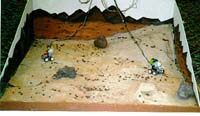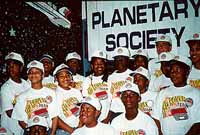Should Students Select A Wet Spot For A Mars Landing Site?
Malin Space Science Systems, Discoverers of Possible Recent Water on Mars, Will Help Mentor Winning Students in Red Rover Goes to Mars
Michael Malin and Ken Edgett of Malin Space Science Systems
 -- the discoverers of possible recent liquid water on Mars -- will work directly with the winning students in The Planetary Society's Red Rover Goes to Mars project to help the kids image a potential landing site for a future Mars sample return mission.
-- the discoverers of possible recent liquid water on Mars -- will work directly with the winning students in The Planetary Society's Red Rover Goes to Mars project to help the kids image a potential landing site for a future Mars sample return mission.
The first round of the Red Rover Goes to Mars selection process has just ended with the submission of hundreds of essays by young people worldwide, aged 9-15, vying for a spot on the Student Scientist team. Students from 43 nations have submitted essays to the Student Scientist Essay Contest, and the discovery of erosion on Mars that suggests the presence of recent liquid water is sure to pique their interest. Winners will be announced in the fall.
Red Rover Goes to Mars, a joint educational program with the LEGO Company, is the first time individuals from the general public will be allowed to be part of a planetary exploration mission. Children have two opportunities to participate -- as Student Scientists or as Student Navigators.
The selected Student Scientists
 will work with actual data from the Mars Global Surveyor (MGS) spacecraft currently in orbit around Mars, as well as with data from the Viking mission, to pick out a candidate landing site on Mars. Once the team has decided on a designated area, they will then travel to Malin Space Science Systems in San Diego, California to create the commands for the MGS Mars Orbiter Camera to take a high-resolution picture of the landing site they have chosen. The camera was designed and is operated by Malin Space Science Systems.
will work with actual data from the Mars Global Surveyor (MGS) spacecraft currently in orbit around Mars, as well as with data from the Viking mission, to pick out a candidate landing site on Mars. Once the team has decided on a designated area, they will then travel to Malin Space Science Systems in San Diego, California to create the commands for the MGS Mars Orbiter Camera to take a high-resolution picture of the landing site they have chosen. The camera was designed and is operated by Malin Space Science Systems.
"The discovery of possible liquid water on Mars could not have come at a better time for our students in the Red Rover Goes to Mars Contest," said Linda Kelly, Education Manager at The Planetary Society. "Not only will this information give them a whole new set of data to consider in selecting a potential landing site for a Mars mission, but they will also be thrilled to work directly with Mike Malin -- the man who helped make this important discovery -- to image the site they choose."
Participants who applied to become Student Scientists can also apply to become Student Navigators. Applicants must be between the ages of 9 and 15 years old to enter the contest. The deadline for the Student Navigator Journal Contest is November 15, 2000.
A full-scale Mars terrain will be constructed based upon the work of the Student Scientists and from children around the world who submit their drawings in a yet-to-be-announced competition. Student Navigators will explore that simulated Mars terrain with a robotic vehicle.
Complete rules and judging criteria can be obtained from The Planetary Society by visiting the website at http://planetary.org or by calling the Society at (626)793-5100.
The Red Rover Goes to Mars program is an outgrowth of the Red Rover, Red Rover program -- a joint development of The Planetary Society, the Center for Self-Organizing and Intelligent Systems at Utah State University, Visionary Products, Inc., and the LEGO Company. Using computers linked through the Internet, students teleoperate robotic rovers built from LEGO Dacta components. 400 Red Rover, Red Rover sites are already established in classrooms and science centers worldwide.
Red Rover Goes to Mars is sponsored by The Planetary Society and the LEGO Company, with Liberte Yogurt of Canada, Science Magazine, and the AAAS Directorate for Education and Human Resources, in cooperation with NASA, the Jet Propulsion Laboratory, Malin Space Science Systems, ASU Mars K-12 Education Program, and Visionary Products, Inc. The LEGO Company has been a principal partner with The Planetary Society in the development of Red Rover, Red Rover.
For more information about the Red Rover Project, click on the links below:
THE PLANETARY SOCIETY:
Carl Sagan, Bruce Murray and Louis Friedman founded The Planetary Society in 1980 to advance the exploration of the solar system and to continue the search for extraterrestrial life. With 100,000 members in over 140 countries, the Society is the largest space interest group in the world.
| 
